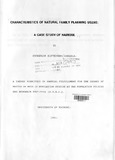| dc.description.abstract | Natural Family Planning (NFP) , which is the core of this study,
is a method of birth regulation which does not involve the use of
chemicals mechanical gadgets or operations. It involves the use
of fertility awareness of the female's cycle.
The thesis intended to find out some of the socio-cultural,
economic, behavioral and demographic attributes which characterizes
the users of NFP methods. Here the selected variables for study
included ethnicity, religion, occupation, educational level,
difficulty in abstinence, spousal communication, age and duration
of marriage. The other main objective of the study was examination
of the perceived advantages and disadvantages associated with the
use of NFP methods.
From the review of literature, the study found out that some
primitive form of Natural Family Planning has been in use since
ancient times according to Ramaswamy (1976), Guzzetti (1980) and
Babara (1982), and it was not until 1930's when the modern NFP
methods were discovered (C.D.C. 1983). The literature indicated
that the characteristics of NFP users are varied and findings from
different researches and regions at times seem to conflict as shown
by findings on religion characteristics which ranges from Catholics
to non-christian regions (Borkman et all 1983). However the
literature reviewed generally concurred that NFP users are
characterized by high level of couple communication, varied socioeconomic,
socio-cultural and demographic attributes while the
perceived advantages include absence of side effects and marriage
enrichment and chief disadvantages is lack of husband co-operation
as shown by works of Ramaswany (1976), Hatches (1980) Borkman et al
(1983), Lancot et al (1984), Klan(1986), IISNFP, Gundy (1987), and
Kiura (1990).
The study, using descriptive statistical techniques, found out
that socio-cultural, economic, behavioral and demographic
characteristics of NFP users are generally similar to those of
artificial users, and thus concluded in general terms that NFP
methods, if given emphasis in all family planning clinics can be
accepted and used by varied number of people. One significant
different between NFP and artificial users, found by the study was
the existence of high level of couple communication and cooperation
among NFP users, while little among artificial users.
Significant advantages given for NFP use included marriage
enrichment and lack of side effects (37.6%; 56.5%) while the most
mentioned disadvantaged is the creation of tensions between the
spouses during the fertile phase of the woman's cycle (1.2%; 34.3%)
from NFP and artificial users respectively.
The study using its findings made some recommendations which
include the need to widely disseminate the correct and most modern
NFP services to dispel the widespread ignorance among the public
and thus to enhance its use in the country and the need to
underline the values associated with it in its teaching. Research
recommendations include the need to investigate the various
determinants of NFP acceptance and its continued use, inter alia | en |

